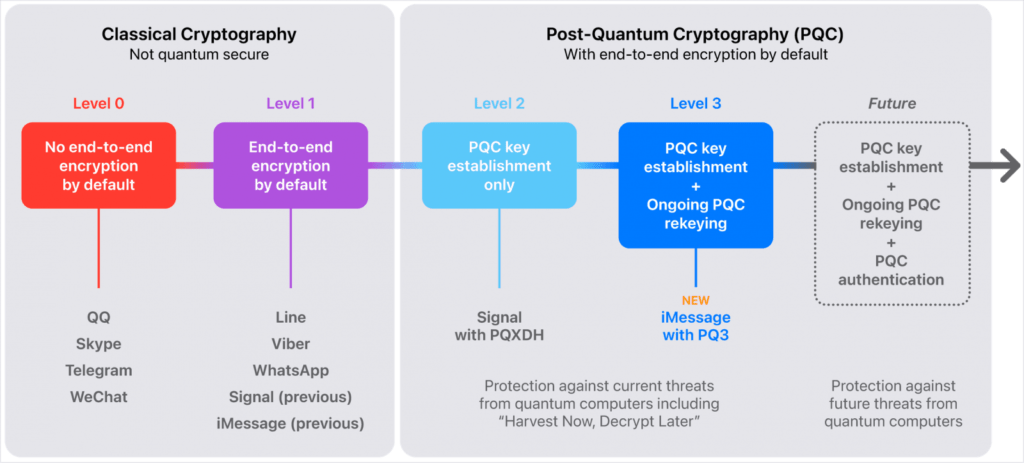
The future of secure communication has arrived ! Apple just struck a major blow to the instant messaging world by incorporating PQ3 post-quantum encryption into iMessage. This major advance offers unprecedented protection against quantum attacks, which threaten to render traditional cryptographic schemes obsolete.
What is post-quantum cryptography?
Quantum computing is advancing by leaps and bounds, and with it, the threat of hacking into today’s encrypted data. Quantum computers, thanks to their amazing computing power, could break classical encryption algorithms in the blink of an eye. This is where post-quantum encryption comes in, designed to resist these future attacks.
PQ3: Level 3 security for iMessage

Apple spares no expense in ensuring the security of iMessage communications. PQ3 is not a simple replacement of the old system, but rather an addition that enhances protection in new ways. This new protocol is the result of a collaboration with cryptography experts and is based on the Kyber algorithm, recognized by NIST for its robustness.
The revolutionary features of the PQ3
- Initial key installation : Encryption keys are generated at the beginning of the conversation, even if the recipient is offline.
- Postquantum periodic key change : Keys are regenerated regularly to ensure optimal security against evolving attacks.
- Recover compromised keys : In case of compromise, new keys are generated without affecting ongoing conversations.
A huge step forward for communications security
The integration of PQ3 into iMessage is a major step forward in securing communications at scale. Apple thus establishes itself as a leader in data protection and encourages other market players to follow its example.
Technical function PQ3

PQ3 is based on a hybrid model that combines the proven ECC algorithm and the new Kyber for optimal security. The encryption process consists of several steps:
- Diffie-Hellman (DH) key exchange. : Devices establish a secure communication channel by exchanging public keys.
- Protocol negotiation : Devices agree on which encryption algorithms to use, including PQ3 and ECC.
- Message encryption : Messages are encrypted symmetric with a randomly generated session key.
- Message authentication : Digital signatures guarantee the integrity and authenticity of messages.
PQ3’s introduction to iMessage is transparent to users, meaning they don’t need to take any action to take advantage of its security benefits. Security is enhanced in the background, without any interruption or impact to the smooth flow of communications.
Here are some more details about PQ3’s impact on the user experience:
- Compatibility : PQ3 is compatible with current versions of iMessage on iOS and macOS. Users do not need to update their device to enjoy the increased security.
- Implementation : PQ3 was designed to be efficient and not have a significant impact on battery life or device performance.
- Privacy : PQ3 does not collect additional personal data or usage data. User privacy remains a top priority for Apple.
- Ease of use : PQ3 is easy to use and requires no special technical knowledge. Users can continue using iMessage as they normally do without worrying about security.
Apart from these points, here are some other aspects to consider:
- Adoption by other platforms : Apple’s integration of PQ3 could encourage other messaging platforms to adopt post-quantum encryption solutions, which would help improve the security of digital communications in general.
- Future Developments : The field of post-quantum cryptography is constantly evolving. Apple is committed to monitoring progress and updating PQ3 as necessary to ensure optimal protection against future threats.
In conclusion, the implementation of PQ3 in iMessage is an important step in securing large-scale communications. This Apple innovation provides strong protection against future quantum attacks without affecting the user experience.

5 Responses